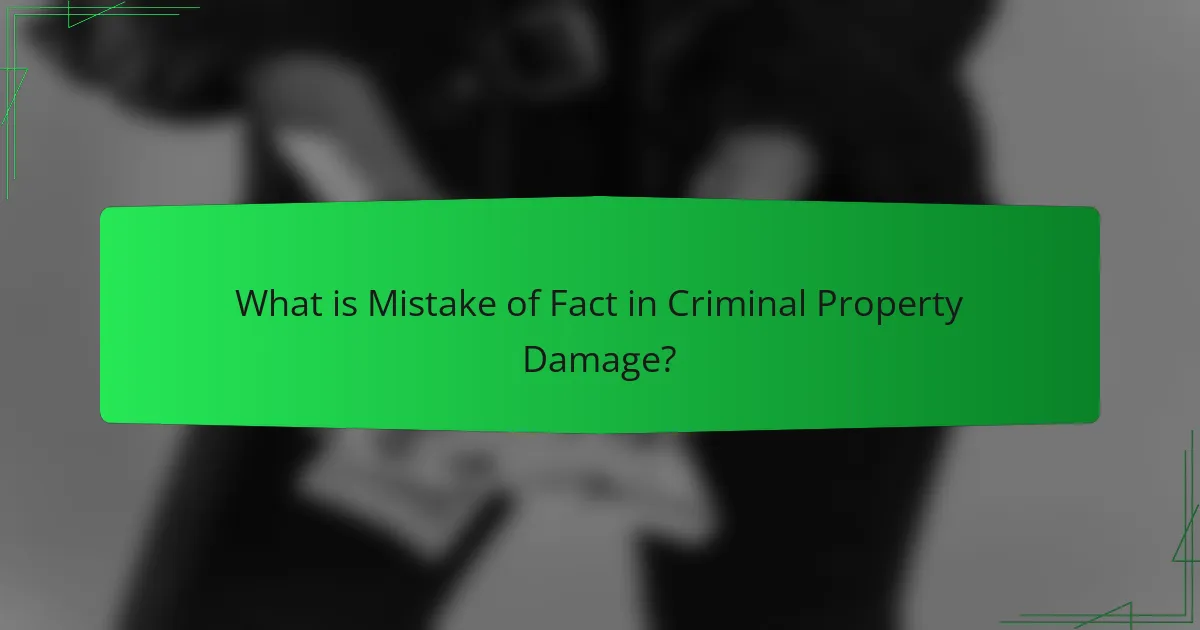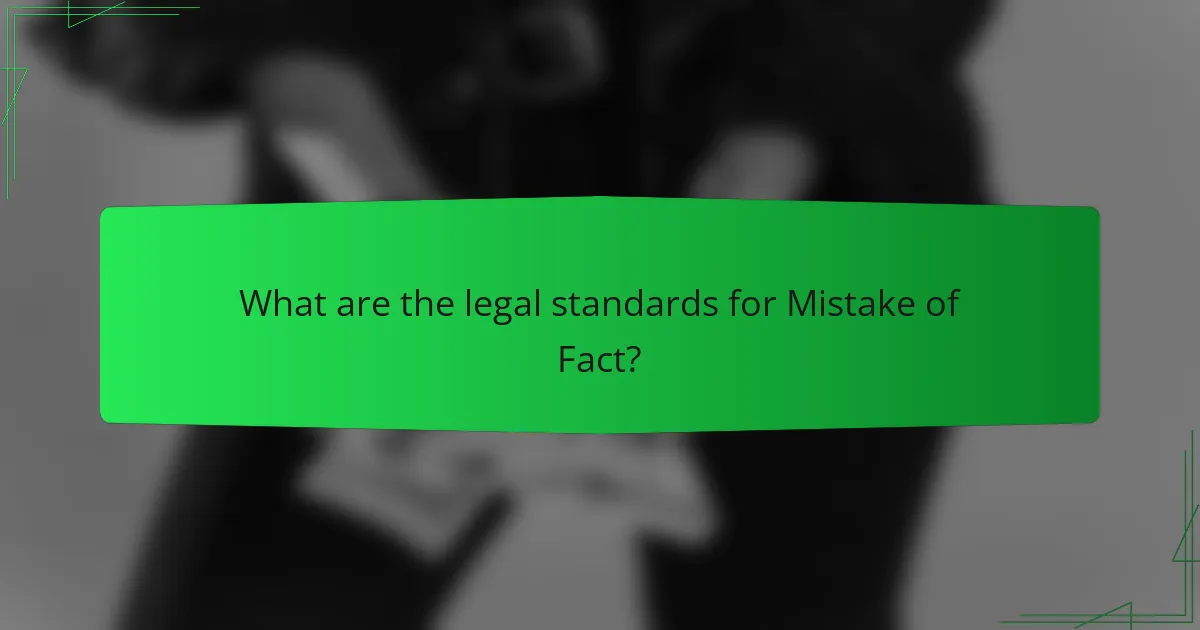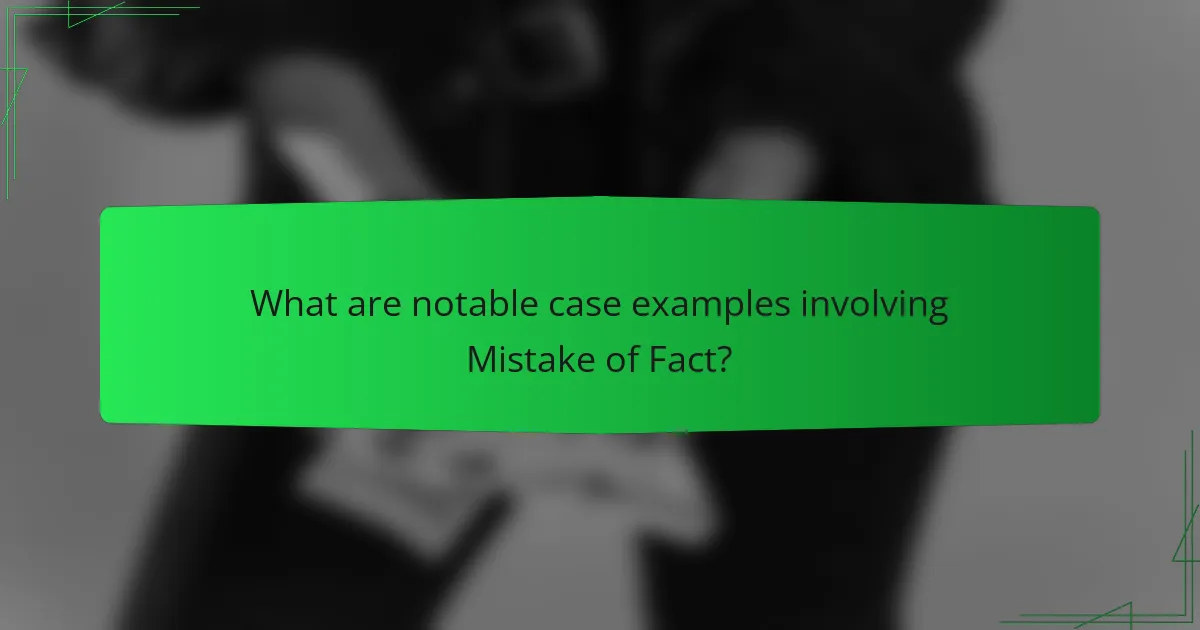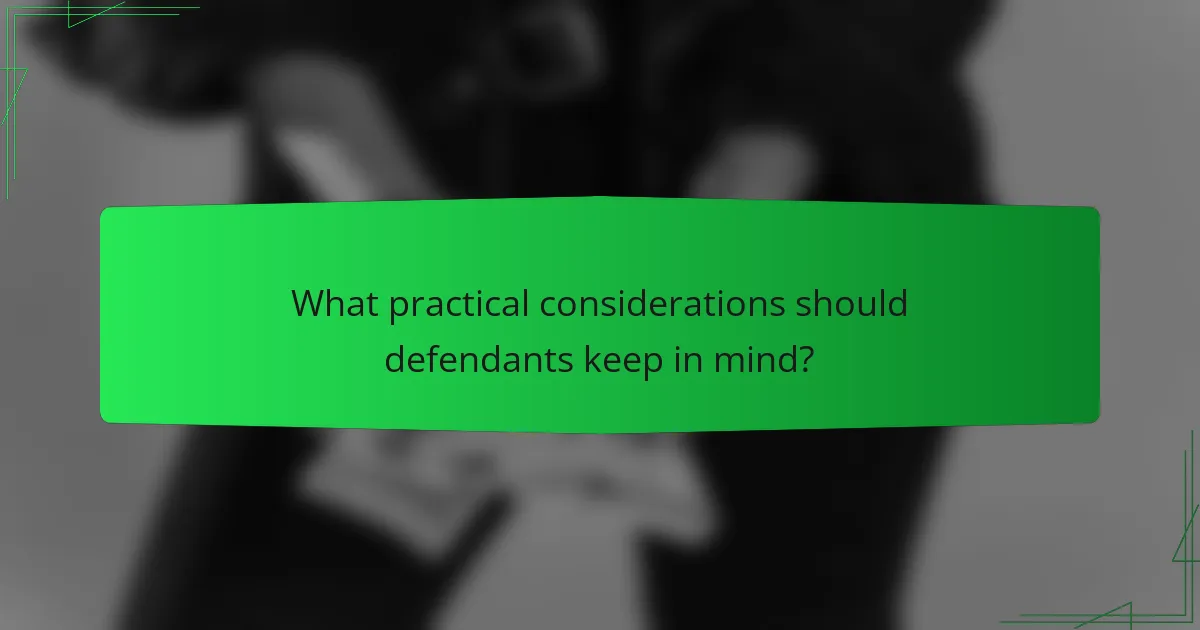Mistake of fact in criminal property damage refers to a misunderstanding of a factual circumstance that negates the criminal intent to damage property. This legal concept asserts that if an individual mistakenly believes they have permission to damage property, they may not be held criminally liable. The article explores the legal standards surrounding this concept, emphasizing that a valid mistake must be both honest and reasonable to serve as a defense. It includes notable case examples such as R v. Smith (1974) and R v. Smith (2007), which illustrate how this principle can influence legal outcomes. Additionally, the article highlights the importance of understanding jurisdiction-specific laws and gathering supporting evidence for a successful defense in cases of property damage.

What is Mistake of Fact in Criminal Property Damage?
Mistake of fact in criminal property damage refers to a misunderstanding about a factual circumstance that negates the intent to commit the crime. This legal concept asserts that if an individual mistakenly believes they have permission to damage property, they may not be held criminally liable. For example, if someone thinks they are damaging their own property, this may qualify as a mistake of fact. Courts often evaluate whether the belief was reasonable under the circumstances. A valid mistake of fact can serve as a defense in criminal cases involving property damage. This principle is rooted in the idea that intent is a crucial element of criminal liability.
How is Mistake of Fact defined in legal terms?
Mistake of Fact is defined in legal terms as a misunderstanding or incorrect belief about a fact that negates liability for a crime. This legal doctrine applies when a person commits an act under the impression that certain facts exist, which, if true, would render the act justifiable or excusable. For example, if someone takes property believing it to be theirs, this belief can serve as a defense against theft charges. Courts often assess whether the mistake was reasonable and whether it negates the intent required for the crime. In many jurisdictions, a mistake of fact can lead to acquittal if it demonstrates a lack of criminal intent.
What are the key elements of Mistake of Fact?
The key elements of Mistake of Fact include a misunderstanding of a fact that negates criminal intent. This mistake must be reasonable and genuine. The defendant must prove that they acted under this misunderstanding. The mistake must relate to a fact that is material to the offense. If the mistake negates the required mental state, it can lead to a defense against liability. Courts often evaluate the reasonableness of the mistake based on the circumstances. This principle is rooted in the notion that liability requires a culpable mental state.
How does Mistake of Fact differ from other legal defenses?
Mistake of Fact is a legal defense based on a misunderstanding of a fact that negates culpability. Unlike other defenses, such as Mistake of Law, which involves incorrect interpretations of legal statutes, Mistake of Fact focuses on factual inaccuracies. This defense applies when a person has a genuine belief that their actions are lawful due to a misperception of facts. For example, if someone takes another’s property believing it to be theirs, this defense may apply. Other defenses, like self-defense or insanity, address different aspects of culpability, such as justification or mental state. Mistake of Fact specifically requires that the misunderstanding be reasonable and not based on negligence. Courts often evaluate the reasonableness of the belief in the context of the situation. This distinction sets Mistake of Fact apart from defenses that rely on legal interpretations or justifications for actions.
Why is understanding Mistake of Fact important in criminal law?
Understanding Mistake of Fact is crucial in criminal law because it can determine the liability of an individual. This legal doctrine allows a defendant to argue that they had a misunderstanding about a fact that negates the intent required for a crime. For example, if someone mistakenly believes they are taking their own property, this misunderstanding can lead to a defense against theft charges. Courts often assess the reasonableness of the belief to evaluate its validity. A successful Mistake of Fact defense can result in acquittal or reduced charges. This principle underscores the importance of intent in criminal liability. It also emphasizes the need for clear communication of laws and expectations to prevent unjust penalties.
What implications does Mistake of Fact have for defendants?
Mistake of Fact can significantly impact defendants in criminal cases. This legal principle allows defendants to argue that their misunderstanding of a fact negates culpability. If a defendant genuinely believed they were acting legally, they may be acquitted. Courts assess whether the mistake was reasonable and if it negated intent. For example, if a defendant mistakenly believes they own a property, they may avoid liability for damage. This defense hinges on the specifics of each case and the nature of the mistake. Successful use of this defense can lead to reduced charges or outright dismissal. Legal precedents show varying outcomes based on the reasonableness of the defendant’s belief.
How can Mistake of Fact affect case outcomes?
A Mistake of Fact can significantly influence case outcomes by potentially negating criminal liability. When a defendant genuinely believes a fact that, if true, would make their actions lawful, this can lead to acquittal. For example, if someone damages property believing it belongs to them, this mistake can be a defense. Courts often evaluate the reasonableness of the belief in determining liability. If the belief is deemed reasonable, it may result in a not guilty verdict. This principle is rooted in the idea that intent is a crucial factor in criminal law. Legal precedents show that successful claims of Mistake of Fact have led to varied case results, reinforcing its impact on outcomes.

What are the legal standards for Mistake of Fact?
The legal standards for Mistake of Fact vary by jurisdiction. Generally, a mistake of fact occurs when a person has a false belief about a fact that negates the intent required for a crime. This means the individual did not know or could not reasonably know the true facts. Courts often assess whether the mistake was reasonable. If the mistake is deemed reasonable, it may serve as a defense against liability. The Model Penal Code recognizes this defense under certain circumstances. For example, if a person mistakenly believes they own property and damages it, this could negate criminal intent. Legal precedents reinforce that the mistake must be honest and reasonable to be valid.
How do courts interpret Mistake of Fact in property damage cases?
Courts interpret Mistake of Fact in property damage cases as a defense that negates liability. This defense applies when a party acted under a false belief about a fact that, if true, would have made their actions lawful. For instance, if a person mistakenly believes they own a property and damages it, they may claim a Mistake of Fact. Courts assess whether the belief was reasonable and whether it negated the intent to cause harm. The key factor is the reasonableness of the mistaken belief at the time of the incident. Established case law, such as *R v. Williams*, illustrates how courts evaluate the subjective understanding of the defendant. Courts require evidence to support the claim of a reasonable mistake.
What is the role of intent in Mistake of Fact claims?
Intent plays a crucial role in Mistake of Fact claims. These claims arise when a person has a false belief about a fact that negates the intent required for a crime. In criminal law, intent typically refers to the mental state of the individual at the time of the act. A genuine mistake of fact can lead to a lack of culpability if it negates the requisite intent. For instance, if a person mistakenly believes they own an item and takes it, their intent to commit theft may be absent. Courts often evaluate the reasonableness of the belief to determine if the mistake was genuine. If the mistake is proven, it can serve as a defense, leading to potential acquittal. Thus, intent is central to establishing the validity of a Mistake of Fact claim in criminal property damage cases.
How do different jurisdictions approach Mistake of Fact?
Different jurisdictions approach Mistake of Fact with varying standards and applications. In some states, a mistake of fact can serve as a complete defense to criminal liability. For instance, California allows defendants to argue that they believed their actions were lawful based on a misunderstanding of fact. Conversely, jurisdictions like New York may limit the defense to situations where the mistake negates the required mental state for the offense. Additionally, federal law typically requires that the mistake be reasonable to be considered valid. Courts often evaluate the reasonableness of the mistake based on the circumstances surrounding the case. This difference reflects the broader legal principles and philosophies that underpin criminal law in each jurisdiction.
What are common misconceptions about Mistake of Fact?
Common misconceptions about Mistake of Fact include the belief that it applies universally to all criminal cases. In reality, it is only applicable in specific circumstances where the defendant held an honest and reasonable belief in a fact that negates culpability. Another misconception is that a mere misunderstanding can absolve someone of liability. However, the mistake must be reasonable and directly relate to the legal definition of the crime. Some people think that ignorance of the law can be a mistake of fact, but this is incorrect; mistakes of fact pertain to factual beliefs rather than legal knowledge. Additionally, there is a belief that all mistakes of fact are treated the same way in court, while the outcome often depends on jurisdiction and case specifics. These misconceptions can lead to confusion about the legal standards and defenses available in criminal property damage cases.
How can misunderstandings impact a defendant’s case?
Misunderstandings can significantly impact a defendant’s case by leading to incorrect assumptions about intent or actions. These misinterpretations can affect the jury’s perception of the defendant’s culpability. For instance, if a defendant is perceived as having malicious intent due to a misunderstanding, it can result in harsher penalties. Additionally, misunderstandings can complicate the presentation of evidence, potentially obscuring the truth. In legal scenarios, a lack of clarity can lead to wrongful convictions. Studies show that miscommunications in court can alter the outcomes of trials. For example, the National Institute of Justice highlights that jurors often rely on their interpretations, which can be flawed. Therefore, misunderstandings can undermine the fairness of the judicial process.
What are the challenges in proving Mistake of Fact?
Proving Mistake of Fact poses several challenges. One challenge is demonstrating that the defendant had a genuine misunderstanding of a fact. This requires clear evidence of the defendant’s belief at the time of the incident. Another challenge is the burden of proof, which lies with the defendant to establish the mistake. The legal standard for what constitutes a reasonable belief can also complicate matters. Courts often scrutinize the context and details surrounding the alleged mistake. Additionally, juries may have biases that affect their perception of the defendant’s intent. These factors can make it difficult for defendants to successfully argue their case.

What are notable case examples involving Mistake of Fact?
Notable case examples involving Mistake of Fact include R v. Smith (1974) and R v. Smith (2007). In R v. Smith (1974), the defendant mistakenly believed he had permission to take a vehicle. This belief led to his acquittal on theft charges due to the genuine mistake. In R v. Smith (2007), the defendant took a bag, thinking it was his. The court ruled that his mistake negated the intent required for theft. These cases illustrate how Mistake of Fact can impact legal outcomes in property damage cases.
What are some landmark cases in criminal property damage?
Landmark cases in criminal property damage include “People v. McDonald,” “State v. McCoy,” and “Commonwealth v. McCarthy.” In “People v. McDonald,” the court ruled on the necessity of intent in property damage cases. The decision clarified that reckless behavior could constitute criminal damage. “State v. McCoy” addressed the issue of mistaken belief in ownership leading to property damage. The ruling emphasized the importance of intent and knowledge in such cases. “Commonwealth v. McCarthy” involved a dispute over vandalism and the interpretation of property rights. This case highlighted the legal definitions of property damage and the implications of intent. Each case contributes significantly to the understanding of criminal property damage law.
How did these cases shape the understanding of Mistake of Fact?
These cases clarified the legal principle of Mistake of Fact in criminal law. They established that a genuine misunderstanding of a fact can negate criminal intent. For instance, in the case of R v. Smith, the court ruled that a defendant’s belief about ownership was reasonable. This case demonstrated that the subjective belief of the defendant is critical in assessing culpability. Similarly, in R v. Smith (1974), it was emphasized that a mistake must be honest and reasonable to be excusable. These rulings shaped the understanding that Mistake of Fact can serve as a defense if the belief was genuine and based on reasonable grounds. Overall, these cases significantly influenced how courts evaluate intent and belief in criminal property damage cases.
What lessons can be learned from these case outcomes?
Lessons from these case outcomes include the importance of understanding the legal definitions of ‘mistake of fact.’ Clear comprehension can prevent wrongful convictions. Additionally, these cases highlight the necessity for defendants to present credible evidence of their beliefs. This evidence can significantly influence jury perceptions. Furthermore, the outcomes demonstrate that subjective beliefs may not always absolve liability. Courts often prioritize objective standards over personal beliefs. Finally, these cases underscore the role of thorough legal counsel in navigating complex defenses. Effective representation can impact the interpretation of facts and outcomes significantly.
How do case examples illustrate the application of Mistake of Fact?
Case examples illustrate the application of Mistake of Fact by demonstrating how misunderstandings can affect legal outcomes. In the case of R v. Smith, the defendant believed he had permission to enter a property. This misunderstanding led to a finding of no criminal intent. Another example is the case of R v. Smith (1983), where the defendant mistakenly took someone else’s property, believing it was his own. The court recognized this mistake as a valid defense. These cases show that a genuine mistake can negate the intent required for criminal liability. Courts often assess the reasonableness of the defendant’s belief in such cases. The outcomes highlight the importance of context in determining liability. Thus, case examples provide clear instances of how Mistake of Fact operates within criminal law.
What factors influenced the decisions in these cases?
Factors influencing decisions in these cases include the nature of the mistake of fact, the intent of the defendant, and the circumstances surrounding the incident. Courts evaluate whether the mistake was reasonable and if it negated criminal intent. The specific context of each case, including evidence presented and witness testimonies, also plays a crucial role. Legal precedents set by previous rulings impact how judges interpret the law in similar situations. Additionally, the jurisdiction’s standards for determining culpability affect outcomes. These elements collectively guide the courts in reaching their verdicts.
How did the courts evaluate the evidence presented?
The courts evaluated the evidence presented by examining its relevance and admissibility. They assessed whether the evidence directly supported the claims made by the parties involved. The courts also considered the credibility of witnesses and the reliability of documents. Additionally, they analyzed the context in which the evidence was obtained. Legal standards such as the burden of proof were applied in determining the weight of the evidence. Courts often relied on precedents to guide their evaluations. This systematic approach ensures fair and just outcomes in legal proceedings.

What practical considerations should defendants keep in mind?
Defendants should keep in mind the importance of understanding the legal definition of mistake of fact. This concept can significantly impact their case in criminal property damage. They must gather evidence to support their claim of a genuine mistake. Documentation, photographs, and witness statements can be crucial. Consulting with an experienced attorney is essential for navigating legal complexities. Defendants should also be aware of the potential consequences of their actions. Understanding the jurisdiction’s specific laws can influence their defense strategy. Preparing for court appearances and being respectful can positively affect the outcome.
What steps can defendants take if they believe they have a Mistake of Fact defense?
Defendants believing they have a Mistake of Fact defense should first gather all relevant evidence. This includes documents, photographs, or witness statements that support their claim. Next, they should consult with a qualified attorney experienced in criminal law. An attorney can provide legal advice tailored to the specifics of the case. Defendants should clearly communicate the details of their misunderstanding to their attorney. They may also need to prepare for potential court proceedings. Presenting the evidence effectively is crucial during hearings or trials. This approach helps establish the validity of the Mistake of Fact defense.
How can legal counsel assist in building a Mistake of Fact argument?
Legal counsel can assist in building a Mistake of Fact argument by providing expertise in legal definitions and precedents. They analyze the facts of the case to identify potential misunderstandings that could negate intent. Counsel gathers evidence to support the claim that the defendant held a genuine belief about the facts. They may interview witnesses to corroborate the defendant’s perspective. Legal counsel also prepares legal documents that articulate the Mistake of Fact defense clearly. They can present arguments in court, referencing relevant case law to strengthen the defense. Furthermore, they help in strategizing the overall defense approach based on the specific circumstances. This combination of analysis, evidence gathering, and legal presentation is crucial for a successful argument.
What evidence is critical for supporting a Mistake of Fact claim?
Critical evidence for supporting a Mistake of Fact claim includes clear proof of the defendant’s misunderstanding. This misunderstanding must relate directly to a factual element of the case. Documentation or testimony demonstrating the defendant’s belief in the mistaken fact is essential. For instance, evidence may include emails, texts, or witness statements confirming the defendant’s perception. Additionally, circumstantial evidence that aligns with the mistaken belief can strengthen the claim. Courts often require that the mistaken fact be reasonable under the circumstances. Therefore, evidence showing the context of the situation is crucial. This context helps establish that the belief was not only genuine but also justifiable.
Mistake of Fact in criminal property damage refers to a misunderstanding about a factual circumstance that negates the intent to commit a crime, allowing individuals to argue against liability if they genuinely believed their actions were lawful. The article defines this legal concept, outlines its key elements, and differentiates it from other defenses. It discusses the importance of intent in establishing liability, the varying legal standards across jurisdictions, and notable case examples that illustrate how courts interpret Mistake of Fact. Additionally, it highlights practical considerations for defendants and the critical evidence needed to support a Mistake of Fact claim.